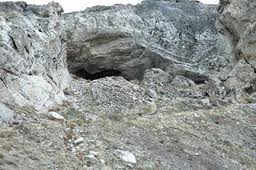Growing up we all heard stories of larger than life or “Giant” peoples from our historic tales. What if there was more truth to them than we were taught? The Paiute Indians of Nevada tell a story of their ancestors that begins some 15,000 years ago when they came to North America. They tell of a race of red-haired giants that lived here when the Paiute arrived. Some standing as tall as 12’ (some exaggeration can be expected) and being alleged cannibals the Paiute had many battles with this group and even named them in their folklore. They were called the Si-Te-Cah which means “tule-eaters”. The tule being a reed like plant the giants used to make rafts out of in order to cross streams or rivers and to flee the attacking Paiute by crossing Lake Lohontana a once massive body of fresh water in the region. Joining forces with all the neighboring tribes the Paiute set out to rid themselves of the giants once and for all. After several battles the Paiute chased the remaining few Si-Te-Cah into a cave. Demanding they come out to fight the Paiute swarmed the cave in wait. With the giants refusing to come out of the cave the chief of the Paiute gave the order to fill the cave mouth with brush and set it ablaze. With the fire burning some of the Si-Te-Cah ran out only to be swiftly killed by the waiting Paiute. The others died inside the cave of smoke inhalation. Much later an earthquake hit the region, sealing the cave entrance to all but the area bats that took up life there. And so ends the tale of Paiute folklore as told to early settlers for hundreds of years…or is it?
It seems that in the early 1900’s bat guano (feces) was in high demand because when it decays it becomes saltpeter, a key ingredient in gunpowder and very valuable at the time. A business booms and people start clearing and opening old caves and mines. In 1911 a small cave is opened outside the town of Lovelock, Nevada and found to be packed with this smelly prized guano. Digging through depths of 6 feet the industrious business men started finding some strange artifacts and remains. In 1912 the University of California sent an archaeologist, Mr. L.L. Loud and some companions to the site, where they worked in the cave from April 1st to August 1st of 1912. They uncovered and cataloged some 10,000 artifacts like the earliest known duck decoys believed in North America, but they also found some things that were much more interesting. In the rear of the cave they uncovered two skeletons, one female and one male. Both showed remnants of long, red hair and both also abnormally tall. The female skeleton measured 6.6 feet tall and the male measured over 8. Knowing the local native legends they inspected the mouth of the cave more closely. Finding what was left of it as well as the ceiling to show signs of a large fire having burned it. The group found many artifacts belonging to the Paiute, like tools, pottery and stone arrow and spear tips but no explanation for the giant skeletons. Loud returned in 1924, to finish his study of the cave and wrap up any loose ends. But the story doesn’t stop there either, in fact more would add to it over the next 15 years. In February of 1931, near Lovelock Nevada, in the dry lake bed of Humboldt Lake, there was another surprising discovery. Two large skeletons were found, one 8 and a half feet tall the other nearly 10. Both had been wrapped in a type of gum-covered cloth resembling Egyptian mummies (Nevada Review-miner newspaper, June 19, 1931). In September of 1939 on the Freidman ranch near Lovelock Nevada a skeleton was found measuring 7’7” (Nevada Review-miner newspaper, September 29, 1939. With this information along with so much more talking of this race in North America, maybe we as a people should pay better attention to our long forgotten past.
References: Terrence Aym/Helium.com
Onlinenevada.org/l.l.loud and the beginnings of Nevada archaeology



wonderful post, thank you.
Thanks, Im glad you enjoyed it.
i really appreciate the kind of topics you post here. thanks for sharing us a great information that is actually helpful. good day! lista de email lista de email lista de email lista de email lista de email
The miners were Greeks from the island of Crete during Minoan era.